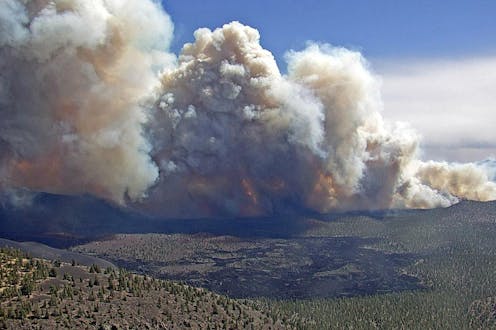The Southwest is on fire, iconic deserts and towns are at risk and one governor is calling for a disaster declaration
- Written by Molly Hunter, Associate Research Professor in Environment and Natural Resources, University of Arizona

New Mexico and Arizona are facing a dangerously early fire season. It has left neighborhoods in ashes and is having such devastating effects that the governor of New Mexico on May 3, 2022, urged President Joe Biden to issue a disaster declaration[1]. Over 600 fires[2] had broken out in the two states by early May, and large wildfires had burned through hundreds of homes near Ruidoso and Las Vegas, New Mexico, and Flagstaff, Arizona.
We asked wildfire scientist Molly Hunter[3] at the University of Arizona to explain what’s fueling the extreme fire conditions and why risky seasons like this are becoming more common.
Why is this year’s wildfire season in the Southwest so early and intense?
Historically, fire season in the Southwest didn’t ramp up until late May or June, because fuels that carry fires – primarily woody debris, leaf litter and dead grasses – didn’t fully dry out until then.
Now, the Southwest is seeing more fires start much earlier[4] in the year. The earlier fire season is partly due to the warming climate[5]. As temperatures rise, the snow melts more rapidly, more water evaporates into the atmosphere and the grasses and other fuels dry out earlier in the season.
Unfortunately, the earlier timing coincides with when the region commonly experiences strong winds[6] that can drive rapid fire growth. Some of the fires we’re seeing this year, like the Tunnel Fire[7] near Flagstaff and the fires in New Mexico, are being driven by these really intense wind events. They’re pretty typical winds for spring, but fuels are now really dry and ready to burn.
This year we also have a lot of fuel to burn. Last summer, in 2021, the Southwest had an exceptional monsoon season[9] that left green hillsides and lots of vegetation. By now the grasses and forbs[10] that established during the monsoon have dried out, leaving a lot of biomass that can carry a fire. Often in the Southwest, our biggest fire years come when we have a wet period followed by a dry period, like the La Niña conditions[11] we’re experiencing now.
What role does climate change play?
In the Southwest, climate change[12] has meant warmer, drier conditions. One immediate effect is the lengthening of the fire season.
We now see fires starting in March and April. And if the Southwest doesn’t get a good summer monsoon – the region’s typical period of heavy rainstorms – fire season won’t really stop until we get significant rainfall or snowfall in fall and winter. That means more stress on firefighting resources, and more stress on communities facing fire, smoke and evacuations.
As fire season lengthens, states are also seeing more fires caused by human activities, such as fireworks, sparks from vehicles or equipment, and power lines. More people are moving[13] out into areas that are fire-prone, creating more opportunities for human-caused ignitions.

